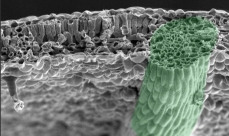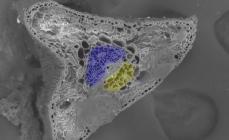Transcription of video clip Vital veins
Irrigation of leaves and needles
To absorb sunlight, leaves have a much larger surface than needles or scales: the blade.
On the other hand, they have to construct veins, to irrigate the blade and maintain its shape.

© Darmouth College (Louisa Howard)
Black walnut leaflet vein
This cross-section of a black walnut leaflet shows a vein.
In the upper part of the blade, turned toward the sun, leaves make maximum use of the plentiful sunlight.
The photosynthetic cells are packed into a zone called the palisade mesophyll.
The leaves' underside contains most of the stomata, responsible for gas exchanges.
The photosynthetic cells are more widely spaced and allow air to circulate. This is the spongy mesophyll.
The veins contain the xylem and phloem, responsible for exchanging water and nutrients with the rest of the tree.
Needles and scales don't have a blade like leaves do, and so don't need veins.

© Jardin botanique de Montréal
Xylem and phloem of a pine needle
The xylem and phloem are in the centre of this pine needle. That's enough to feed all the cells.
Needles also lose less water than leaves.
They have less surface area, and it is often covered with a thicker cuticle than on leaves.
This layer of waterproof wax reduces transpiration by the epidermal cells on the needle's surface.
Leaves, needles and scales have one thing in common: they have to make sure their cells have enough water.
Back to video clip




